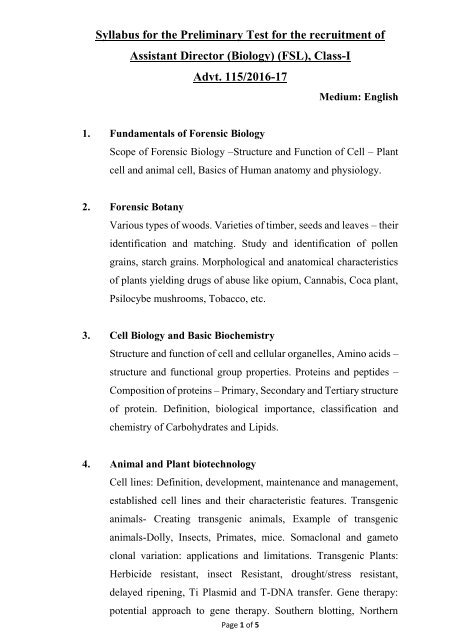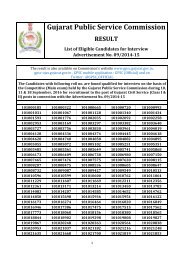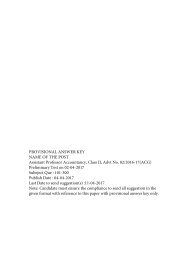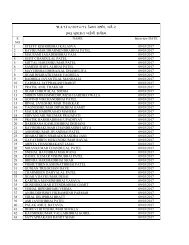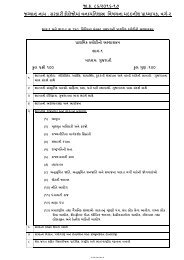1XD9OT4_115-201617
1XD9OT4_115-201617
1XD9OT4_115-201617
You also want an ePaper? Increase the reach of your titles
YUMPU automatically turns print PDFs into web optimized ePapers that Google loves.
Syllabus for the Preliminary Test for the recruitment of<br />
Assistant Director (Biology) (FSL), Class-I<br />
Advt. <strong>115</strong>/2016-17<br />
Medium: English<br />
1. Fundamentals of Forensic Biology<br />
Scope of Forensic Biology –Structure and Function of Cell – Plant<br />
cell and animal cell, Basics of Human anatomy and physiology.<br />
2. Forensic Botany<br />
Various types of woods. Varieties of timber, seeds and leaves – their<br />
identification and matching. Study and identification of pollen<br />
grains, starch grains. Morphological and anatomical characteristics<br />
of plants yielding drugs of abuse like opium, Cannabis, Coca plant,<br />
Psilocybe mushrooms, Tobacco, etc.<br />
3. Cell Biology and Basic Biochemistry<br />
Structure and function of cell and cellular organelles, Amino acids –<br />
structure and functional group properties. Proteins and peptides –<br />
Composition of proteins – Primary, Secondary and Tertiary structure<br />
of protein. Definition, biological importance, classification and<br />
chemistry of Carbohydrates and Lipids.<br />
4. Animal and Plant biotechnology<br />
Cell lines: Definition, development, maintenance and management,<br />
established cell lines and their characteristic features. Transgenic<br />
animals- Creating transgenic animals, Example of transgenic<br />
animals-Dolly, Insects, Primates, mice. Somaclonal and gameto<br />
clonal variation: applications and limitations. Transgenic Plants:<br />
Herbicide resistant, insect Resistant, drought/stress resistant,<br />
delayed ripening, Ti Plasmid and T-DNA transfer. Gene therapy:<br />
potential approach to gene therapy. Southern blotting, Northern<br />
Page 1 of 5
lotting, Western blotting, ISO-electric focusing. Overview of Stem<br />
cells and its applications.<br />
5. Basic Serology<br />
Blood and its composition. Hemoglobin and its variants. Theories<br />
and biochemical tests for the identification of blood. Blood<br />
Typing/Grouping – ‘ABO’ system and its significance in forensic<br />
investigation. Other blood group antigens - ‘Rh sub types’, MN, I,<br />
P, Kell, Duffy, Kidd, Lewis, Lutheran and Bombay blood group.<br />
Forensic Examination of semen and other body fluids – vomit, feces,<br />
urine, saliva and vaginal secretions. Overview of cells and organs of<br />
immune system and basic immunology.<br />
6. Forensic Microbiology<br />
Introduction to microbiology, cellwall composition of Gram positive<br />
and Gram negative bacteria. Sterilization techniques - Physical<br />
agents: Dry heat, wet heat and cold sterilization, filtration, radiation;<br />
Chemical agents (Disinfectants, antibiotics, alcohols) and their<br />
mechanisms. Microbial growth and environmental factors affecting<br />
the growth. Different methods for isolation of microorganisms from<br />
forensic samples like vomit, stool, stomach wash and residual food.<br />
Introduction to biological warfare, general properties of various<br />
biological warfare agents and their toxic effects. Popular case studies<br />
of bioterrorism.<br />
7. Introduction to Recombinant DNA technology<br />
DNA modifying enzymes, Cloning strategies: Genomic libraries,<br />
cDNA libraries, single gene cloning. RAPD, RFLP and AFLP.<br />
Vectors: Types of vectors and choice of vectors- Plasmids, cosmids,<br />
lamda phage vectors, shuttle vectors, BACs and YACs.<br />
Transformation and Transfection. Expression systems in Eukaryotic<br />
Page 2 of 5
cells, Yeast, Bacteria, Insect cell lines, Gene screening. Biosafety<br />
guidelines and containment strategies.<br />
8. Forensic DNA analysis<br />
Chemical structure of DNA and RNA. Overview of DNA<br />
replication, transcription and translation. Procedure for collection<br />
and preservation of biological sample for DNA analysis. Techniques<br />
of DNA isolation and its quantitation. DNA separation techniques.<br />
History of DNA fingerprinting and DNA polymorphism. Genes and<br />
DNA markers in forensic DNA analysis. Introduction to Polymerase<br />
Chain Reaction and its applications. Introduction to mitochondrial<br />
DNA and its forensic importance. Fundamentals of RFLP and PCR<br />
based DNA typing. STR genotyping, Result of STR marker analysis<br />
and its interpretation. Single Nucleotide Polymorphism (SNP) and<br />
its applications in forensic investigation. LCN typing. Mitochondrial<br />
DNA analysis in Forensic investigation. Y-STR analysis and its<br />
significance in establishing paternal relationships. Non-human DNA<br />
analysis.<br />
9. Recent Developments and future Directions in DNA profiling<br />
Methods of DNA sequencing. Prediction of physical characteristics,<br />
such as eye, hair, and skin color based solely on DNA. Molecular<br />
autopsy. Genetic genealogy in the genomic era. Evolving<br />
technologies in forensic DNA analysis. Forensic tissue identification<br />
with nucleic acids: Classical, RNA based and DNA methylation<br />
based approaches.<br />
10. Immunology<br />
Antigen – Epitope, essential factors for antigenicity, haptenes and<br />
adjuvant. Immunoglobulin – structure, classes of immunoglobulin,<br />
antigen – antibody reactions and their techniques in serological<br />
analysis. Application of various polymorphic enzymes and proteins<br />
Page 3 of 5
in criminal investigation. Antigen Processing and presentation.<br />
Production of Monoclonal and polyclonal antibodies, hybridoma<br />
technology. Autoimmunity and hypersensitivity. HLA typing and its<br />
forensic importance. Vaccines, Lectins and their forensic<br />
significance.<br />
11. Environmental Forensic<br />
Introduction and applications of environmental forensic. Principles<br />
and methods of chemical fingerprinting (crude oil and refined<br />
products). Forensic techniques used in environmental litigation.<br />
Environmental forensic microscopy.<br />
12. Nano Biotechnology<br />
Introduction, history and development in nanotechnology. Physical<br />
synthesis of nanoparticles. Biological production of nanoparticles:<br />
fungi, bacteria, yeast and actinomycetes. Properties and<br />
characteristic of nanomaterials. Tool for the characterization of<br />
nanomaterial: Optical microscopy, Electron microscopy (TEM and<br />
SEM), scanning probe microscopy, atomic force microscopy,<br />
fluorescence microscopy. DNA based nanostructure, DNA-protein<br />
nanostructure. Carbon nanotubes, nanorods and fullerens.<br />
Application of nanoparticles as molecular imaging probes (Quantum<br />
dots). Application of nanoparticles as therapeutic drug carriers, gene<br />
delivery and diagnostics. Application of nanomaterials in forensic<br />
and life science. Nanoparticles as a tool for cleaning environment:<br />
Remediation of heavy metal. Nanoparticles as sensors.<br />
13. Forensic Toxicological Examination.<br />
Law relating to poisons. Introduction to Poisons, form of poisons,<br />
classification and methods of administration of poison. Mode of<br />
action of poison, Diagnosis and management of poisoning cases.<br />
Factors affecting the effect of poison and medico-legal aspects in<br />
Page 4 of 5
poisoning cases. Collection and preservation of biological evidences<br />
(viscera and /or body fluids) and circumstantial evidences in fatal<br />
and survival cases. Submission of samples to the laboratory,<br />
postmortem examination, specific analysis plan / approach to<br />
toxicological examinations of poisoning samples. Isolation and<br />
Extraction of poison/ drug by various classical and modern methods<br />
using instrumental techniques.<br />
14. Basic Principles of Pharmacology and Forensic pharmacology<br />
Pharmacopoeias IP, USP, EP. Drug & Drug Receptor mechanisms.<br />
Pharmacodynamics. Factor affecting the effects of Drug. Post<br />
mortem redistribution. Forensic pharmacological studies,<br />
absorption, distribution, pharmacokinetics and metabolism,<br />
pathways of drug metabolism, drug toxicity, excretion of drugs and<br />
poisons. Detection of poison on the basis of their metabolic studies.<br />
15. Regulatory affairs and IPR<br />
Basic principles of quality control (QC) and quality assurance (QA).<br />
Guidelines for QA and QC: raw materials, products and validation.<br />
Introduction to pharmacopoeia. Intellectual Property Rights.<br />
Importance of protecting scientific discoveries. IPR policy of<br />
Government of India. Patent: Qualification (novel, commercial and<br />
non-obvious), jurisdiction of patent laws, Indian and international<br />
patent laws, filing procedures.<br />
16. Current Trends and Recent Advancements in Forensic Biology.<br />
Page 5 of 5


